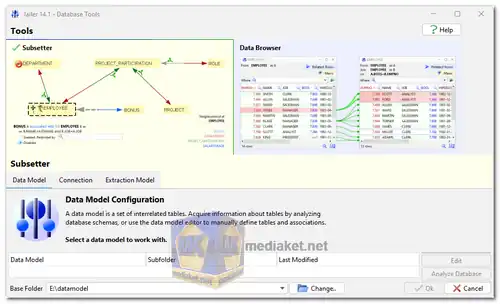Jailer is an open-source database subsetting and data anonymization tool designed to extract consistent and referentially intact data from production databases. It is particularly useful for creating smaller, manageable datasets for development, testing, or anonymizing sensitive data for compliance with data privacy regulations...
Jailer simplifies the process of extracting data from relational databases while preserving data integrity and relationships between tables. It is primarily used for creating subsets of production databases, making it easier and more cost-effective to work with data in development and testing environments. Additionally, Jailer offers features for data anonymization, helping organizations protect sensitive information and meet privacy compliance requirements.
Here's a detailed description of its features:
Data Extraction:
Jailer efficiently extracts data from production databases, ensuring that the resulting dataset maintains referential integrity and consistency.
Data Masking and Anonymization:
It provides tools to anonymize sensitive data, such as personally identifiable information (PII), by applying various data masking techniques. This helps organizations comply with data privacy regulations like GDPR.
Data Subset Generation:
Jailer allows users to create smaller subsets of the database, reducing the size and complexity of datasets for development, testing, and analysis purposes.
Database Schema Visualization:
The tool offers visual representations of the database schema, making it easier to understand the structure and relationships between tables and entities.
Querying and Analysis:
Users can write and execute SQL queries directly within Jailer, enabling powerful data analysis and exploration.
Cross-Platform Compatibility:
Jailer is available for both Windows and Linux, with installation packages (MSI and DEB) provided for convenience. It may include an embedded JRE for Java compatibility.
JDBC Driver Support:
It supports a wide range of popular RDBMS systems, often including the necessary JDBC drivers for database connectivity.
And here are the pros of Using Jailer:
Efficient Data Extraction:
Jailer streamlines the process of extracting data from databases, saving time and effort compared to manual extraction methods.
Data Privacy and Compliance:
Jailer's data anonymization and masking features help organizations protect sensitive data and comply with data privacy regulations, reducing the risk of data breaches.
Database Subset Generation:
It enables the creation of smaller, more manageable database subsets for development and testing, reducing resource consumption.
Database Schema Visualization:
Visual representations of the schema enhance database understanding, making it easier to work with complex data structures.
Querying and Analysis:
The integrated SQL query functionality allows for in-depth data analysis and exploration within the tool.
Cross-Platform Compatibility:
Jailer's availability on Windows and Linux makes it accessible to a wide range of users and environments.
Integrated JDBC Drivers:
Jailer often includes JDBC drivers for popular database systems, simplifying setup and connectivity.
Jailer is a valuable tool for database professionals, developers, and organizations looking to streamline the process of working with databases, especially when dealing with large and complex datasets. Its data extraction, anonymization, and data subset generation capabilities make it a versatile solution for various use cases, contributing to improved data management and compliance efforts. To stay updated on the latest features and capabilities of Jailer, it's advisable to consult the official documentation and community resources.
Prerequisites:
Java JRE 8 (or above) download
Windows and Linux installation programs (*.msi and *.deb) already contain a JRE. If you use them, no further installation is needed.
Important: due to HiDPI graphics support, Java JRE 11 (or above) is strongly recommended.
JDBC-driver for your RDBMS
For many popular database systems a driver is already included.
Jailer - Changelog:
Integration of the Liquibase tool, DDL scripts can now be generated to create database objects. This makes it possible to create subset databases from scratch using only on-board means.
How to use Jailer:
Jailer appears to have two main functionalities: database subsetting and relational data browsing. Here's a general guide on how to use it for each:
For Database Subsetting:
1. Installation:
- Download Jailer.
- Follow the installation instructions specific to your operating system.
2. Starting Jailer:
- On Windows, you can run either "Jailer.exe" or "jailerGUI.bat".
- On Unix/Linux, use the script "jailerGUI.sh" or "java -jar jailer.jar".
3. Creating a Data Model:
- Jailer uses a data model to understand your database structure.
- In the Jailer interface, create a new data model by specifying a name for it (e.g., "mydb_subset").
4. Defining the Subset:
- The data model will allow you to define which tables and data you want to extract from the original database.
- Jailer offers functionalities to filter data based on specific criteria, ensuring referential integrity (avoiding broken links).
5. Exporting the Subset:
- Once you've defined the subset in your data model, Jailer allows you to export it as a new database containing only the desired data.
For Relational Data Browsing:
1. Starting Jailer:
- Follow the same steps as mentioned for database subsetting (running Jailer.exe/jar etc.).
2. Connecting to the Database:
- Jailer provides options to connect to your existing relational database using JDBC drivers.
- You'll need to provide connection details like database URL, username, and password.
3. Browsing Data:
- Once connected, Jailer allows you to browse the schema (structure) of your database tables.
- You can also navigate and view the actual data stored within those tables.
Remember, this is a general overview. For specific functionalities and detailed instructions, consult the official resources or search online for tutorials tailored to your use case.
Install version:
Size: 69.63 MB - Download
Portable version:
Size: 51.50 MB - Download

